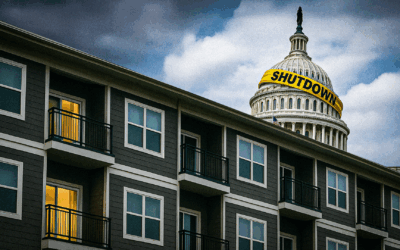Shutdown ‘Chilling Effect’: How It Hits Multifamily—and Where the Opportunity Lies
|
NOV 06, 2025
|
The headline vs. the signal
This shutdown isn’t just a headline—it’s tangibly slowing pieces of the multifamily ecosystem that intersect with federal agencies and programs. According to Bisnow’s detailed rundown, HUD is functioning with significantly reduced staff, new HUD/FHA loan processing is frozen, and federal inspections are paused—all of which drag timelines for affordable and agency-touched projects.
If the standoff persists, the risks compound: Section 8 voucher funds could run out, SNAP benefits may lapse, and the National Flood Insurance Program cannot issue new or renewal policies—a direct hit to deals that require proof of flood coverage to close. Stakeholders on the ground describe a growing “chilling effect” across underwriting, entitlement, and capital markets as uncertainty lingers.
Where the pressure shows up first
➤ Financing & closings: With HUD/FHA new policies on hold, deals in process stall. Developers and borrowers relying on agency execution face clock-risk on rate locks, construction starts, and year-end deliverables.
➤ Inspections & compliance: HUD inspections for subsidized properties are paused, adding backlog that will extend well beyond the shutdown.
➤ Program pipelines: CDFI Fund staffing cuts and HOME program impacts threaten gap financing that many affordable projects depend on; miss a deadline and the capital stack can fall apart. LIHTC deadlines are also at risk—credits are lost every year even without a shutdown.
➤ Tenant pressure: If SNAP funds lapse and voucher renewals freeze, property cash flows tied to those programs face heightened delinquency risk.
➤ Insurance constraints: With NFIP unable to issue new/renewal policies, some acquisitions or refis in flood-exposed areas can’t proceed.
What this means for apartment investors (and why value-add stands out)
1. Relative insulation for market-rate value-add. Properties whose revenue base is primarily market-rate and that don’t require agency touches to transact are less exposed to program pauses. Your risk becomes macro (sentiment/volatility), not administrative (can’t get an inspector, can’t bind NFIP, can’t place HUD debt).
2. Future supply could tighten. The longer federal pipelines stall, the more affordable and mixed-financed projects defer or die. That removed competition tightens the 2026–2027 supply picture, a structural tailwind for well-located existing assets—especially renovated Class B that prices below new Class A.
3. Distress creates selective opportunity. Owners or developers caught mid-process—awaiting HUD actions, CDFI allocations, or LIHTC milestones—may become motivated sellers if delays jeopardize their capital stacks. Experienced operators with private capital and straightforward financing can step in.
How we’re positioning right now
At Faris Capital Partners, we’re emphasizing assets where we can control the outcome without federal chokepoints:
➤ Market-rate value-add in landlord-friendly, high-demand metros (Atlanta, Tampa, Charleston).
➤ Below-replacement-cost acquisitions with day-one cash flow and clear renovation ROI (interiors, smart access, lighting, pet amenities, package solutions).
➤ Conservative underwriting that does not rely on rapid rate cuts or aggressive rent growth—just the normalization we expect as supply pipelines thin post-shutdown.
Where federal exposure exists (e.g., flood insurance requirements), we build contingency timelines and back-up coverage strategies so that execution risk is priced and managed.
What to watch over the next 30–60 days
➤ Voucher & SNAP timelines: Any confirmed shortfalls would raise near-term delinquency risk for properties concentrated in those programs.
➤ HUD restart & backlog: The longer the pause, the larger the post-shutdown queue, stretching affordable project delivery schedules and constraining 2026 supply.
➤ NFIP reauthorization: A quick fix unblocks flood-exposed transactions; a prolonged lapse will freeze closings in specific corridors.
Bottom line
The shutdown is not a broad-brush hit to all multifamily. It is a process and program shock that mainly hurts projects and owners dependent on federal actions or income streams. For market-rate, value-add investors, it can reduce future competition and open selective acquisition windows—provided you buy right and operate well.
If you sat out our last raise, this is the moment to get on the priority list so you see the next opportunity first.
👉 Reserve priority access (no obligation; first look when we open)
👉 Book a 15-minute call to review our current pipeline and risk controls
Our mission is to help investors thrive regardless of what’s happening in the market.
If you’re feeling overwhelmed by economic uncertainty, let’s talk about how real estate can add clarity and confidence to your portfolio.
Ready to connect?
Book a call with our investor relations team today to learn more about current investment opportunities.
Have a question?
Please use the form below to contact us. We will never spam you, or sell your email to third parties.




